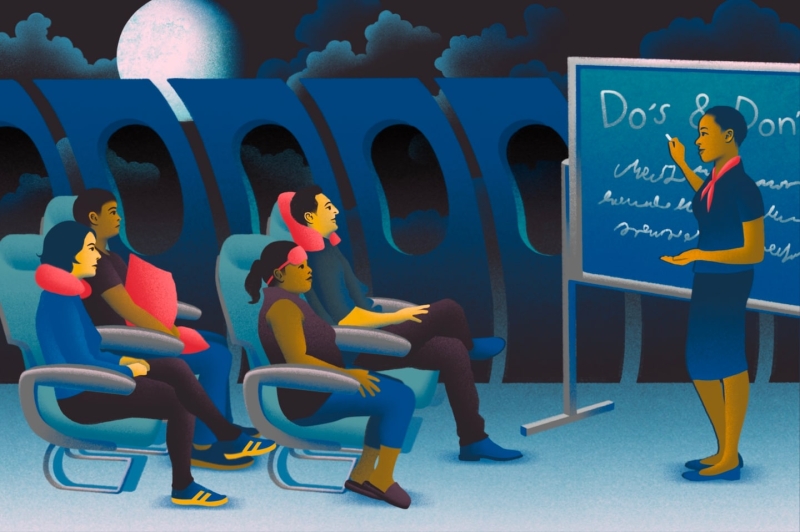Contents
- 1 Overnight flights are basically giant sleepover parties with strangers. Here’s how to behave.
- 1.1 Rule 1: Don’t act like this is your living room couch
- 1.2 Rule 2: Dim the lights and lower the volume
- 1.3 Rule 3: No pajamas and absolutely no bare feet
- 1.4 Rule 4: No stinky midnight snacks
- 1.5 Rule 5: Don’t hog the lavatory for your nightly routine
- 1.6 Rule 6: Handle your snoring seatmate tactfully
- 1.7 Rule 7: No talking or playing with the window shade
- 1.8 More travel tips
Overnight flights are basically giant sleepover parties with strangers. Here’s how to behave.
Sorry, a summary is not available for this article at this time. Please try again later.

Advice by Andrea Sachs
On overnight flights, Lee Abbamonte shows up ready for bed. He wears a brimmed hat to shield his eyes from the lights and noise-cancellation headphones to drown out snoring adults and crying babies. But on a red-eye from Dubai to New York, he was not prepared for the 10-toed monster that intruded on his sleep.
“He was wearing sandals with no socks. He took them off and laid down like he owned the plane,” Abbamonte, a travel expert, said of the ill-mannered passenger in his row. “His feet were like two inches from me. It was absolutely disgusting.”
Overnight flights are basically giant sleepover parties with strangers, where intimate and sometimes embarrassing behaviors are on public display. To survive the night, passengers need to mind their P’s and Z’s in the close sleeping quarters. We spoke with travel veterans and etiquette professionals about how to behave like a dream passenger and handle a nightmarish one.
The best gear to make long flights less miserable
Rule 1: Don’t act like this is your living room couch
If you are fortunate enough to score an open row, don’t immediately set up camp. For safety reasons, sit upright during takeoff and landing. Once the plane reaches cruising altitude, you can stretch out, assuming you are not encroaching on another passenger’s personal space.
“After the plane takes off, give it a second, and if nobody moves over, then do it,” Abbamonte said. “Otherwise, it’s just kind of obnoxious.”
Whether you curl up in a ball or lie flat, keep your seat belt buckled and your feet off the furniture.
“Do not put your feet up on the seat in front of you. Don’t put it on the armrest in front of you. Don’t prop your feet up on the bulkhead,” said Abbie Unger, a former flight attendant and the founder of the Flight Attendant Career Connection, which advises aspiring crew members. “Don’t put your feet on anything.”
Relatedly, if you notice a vacant section during the boarding process, don’t rush over and claim it for yourself. Once everyone is seated, ask the flight attendant whether you can relocate.
Brittney, a flight attendant with a major airline who, for professional reasons, spoke on the condition that only her first name be used, reminds passengers to never occupy the empty back rows without permission. She said some carriers block off those seats for flight attendants who can’t reach their jump seats during a patch of turbulence. Crew members may also move an ill passenger to the aft row so they can have a modicum of privacy and space.
Rule 2: Dim the lights and lower the volume
For most of us, the ideal sleeping environment is dark and quiet. Take your cue from the flight attendants. When they extinguish the cabin lights, lower your light source as well. Close the window shade and, if you’re watching a movie, dim the brightness level on your laptop or seat-back entertainment center.
The overhead seat light is built like a spotlight, its narrow beam illuminating your tiny stage. If you are surrounded by empty seats, don’t switch on all the lights and turn your row into a floodlit concert arena. If you need additional glow, bring a clip-on reading light. Conversely, if you are sensitive to light, pack an eye mask.
The rules of the overhead bin so your flight doesn’t hate you
Airlines require passengers to wear headphones when listening to audio. However, sometimes sound leaks into the wider world. To avoid irritating your neighbors, keep the volume down or invest in quality gear, such as closed-back models or ear buds.
If listening to music helps you fall asleep, Unger favors earmuff-style headphones instead of ear buds, which can pop out while you’re dozing. You don’t want to have to wake your neighbors to ask whether they can check under their seats or feet for your wireless earpiece.
Rule 3: No pajamas and absolutely no bare feet
Pajamas are only appropriate for passengers who still think Ariel is a real mermaid. The rest of us should dress in loose and casual clothing such as leggings, roomy tops, sweatshirts or any attire categorized as loungewear or athleisure.
“It should look like you’re wearing outside clothes, not inside clothes,” Unger said.
Will dressing up get you first class? Flight attendants debunk old myths.
Jamie Gibson, founder of Flightess, an online community for corporate flight attendants, prefers joggers. Because of the elastic ankle cuff, she avoids dragging the pant hem on the lavatory floor and transporting the flotsam back to her seat. For equally pragmatic reasons, Unger recommends a hoodie to block out external stimulus. Abbamonte champions hats as sleepwear.
There is no debate on bare feet. It’s a hard no. Diane Gottsman, owner of the Protocol School of Texas, is also against removing your shoes, because of the risk of foot odor seeping through the sock material. Other experts are more tolerant of shoe removal as long as the socks stay on. Compression socks check two boxes: They hide your bunions and reduce leg swelling. (Consult with a physician about maximum wear time.) Gibson pulls from her stockpile of complimentary hotel slippers.
“They’re easy to slip on and slip off,” she said, “and I can throw them away at the end of the flight.”
Rule 4: No stinky midnight snacks
If you bring your own stash of food, the protocols that apply to daytime meals also include after-hours snacks.
Don’t nosh on any smelly fare, such as sardines or tuna fish, sandwiches or salads with allium or cruciferous vegetables, fermented products such as sauerkraut, or hard-boiled eggs.
Mini Crock-Pots and meal prep: How flight attendants eat on a plane
“You may really be enjoying your fried pickle sandwich, but that doesn’t mean everyone else is going to enjoy the aroma,” Gibson said.
Rule 5: Don’t hog the lavatory for your nightly routine
Most travelers don’t want to spend more time than necessary in germy airplane lavatories, but many of us can’t sleep with an unwashed face and unbrushed teeth.
Unger performs her bedtime rituals in the airport restroom. Before boarding, she will clean her face with a disposable compressed washcloth (another option: a washcloth and a resealable plastic bag), brush her teeth and moisturize with unscented lotion, out of respect for passengers who may be sensitive to fragrances.
Just how germy are airplanes? We put one to the test.
Before settling in, make sure your toiletries are within easy reach. You don’t want to disturb your row-mates by opening the overhead compartment and rummaging through your carry-on for your essentials.
If you don’t mind using the aircraft’s lavatory, bring a bottle of water for wetting your toothbrush and swishing. Tote your toiletries in a hanging bag or place your dopp kit on paper towels to avoid direct contact with the console. To limit your sink water usage, stock up on makeup wipes and pre-pasted waterless toothbrushes. Once you are finished, clean up any puddles or toothpaste globs in the basin or on the counter or floor.
Come morning, you can freshen up before disembarking, but be quick. Bathroom rush hour often falls between breakfast service and landing.
“You’re not taking 40 minutes in that restroom. You’re taking a few minutes to wash your hands and splash water on your face,” Gottsman said. “Don’t use this as an opportunity to bathe.”
Rule 6: Handle your snoring seatmate tactfully
Sleeping in a vertical position, a familiar arrangement for passengers in coach, is often a treatment for snoring, according to Christopher Winter, a sleep specialist and neurologist. Even so, you may still hear a symphony of snorts and nasal whistles.
You asked: I’m stuck in the middle seat. How do I reclaim the armrests?
In these instances, tune out the cacophony with noise-cancellation headphones or earplugs. If that does not work, Unger suggests making slight movements, such as unbuckling your seat belt or folding your tray table, in the hope that the snoring passenger will stir awake and switch positions. If this strategy fails, discreetly flag down the flight attendant and ask for assistance or a new seat.
If you need to use the bathroom and the person in the aisle seat is deep in dreamland, kindly ask to exit. Do not climb over them or poke them, which is neither polite nor safe. And don’t feel bad for rousing them: As the gatekeeper to the lavatory, it’s their responsibility to let you out.
Rule 7: No talking or playing with the window shade
If you notice people pacing, be sensitive to their plight: They might suffer from restless leg syndrome. But if you can help it, avoid strolling the aisles while people are trying to sleep. If you need to stretch during a long flight, go in the back galley area and march in place or perform sun salutations.
Who controls the window shade on a plane? What to do if it’s not you.
Abstain from talking when the rest of the plane is sleeping, and don’t continually lift your window shade to check the position of the sun in the sky. You can open both your mouth and the shade once the flight attendants emerge from the dark with coffee and breakfast.
More travel tips
Vacation planning: Start with a strategy to maximize days off by taking PTO around holidays. Experts recommend taking multiple short trips for peak happiness. Want to take an ambitious trip? Here are 12 destinations to try this year — without crowds.
Cheap flights: Follow our best advice for scoring low airfare, including setting flight price alerts and subscribing to deal newsletters. If you’re set on an expensive getaway, here’s a plan to save up without straining your credit limit.
Airport chaos: We’ve got advice for every scenario, from canceled flights to lost luggage. Stuck at the rental car counter? These tips can speed up the process. And following these 52 rules of flying should make the experience better for everyone.
Expert advice: Our By The Way Concierge solves readers’ dilemmas, including whether it’s okay to ditch a partner at security, or what happens if you get caught flying with weed. Submit your question here. Or you could look to the gurus: Lonely Planet and Rick Steves.

